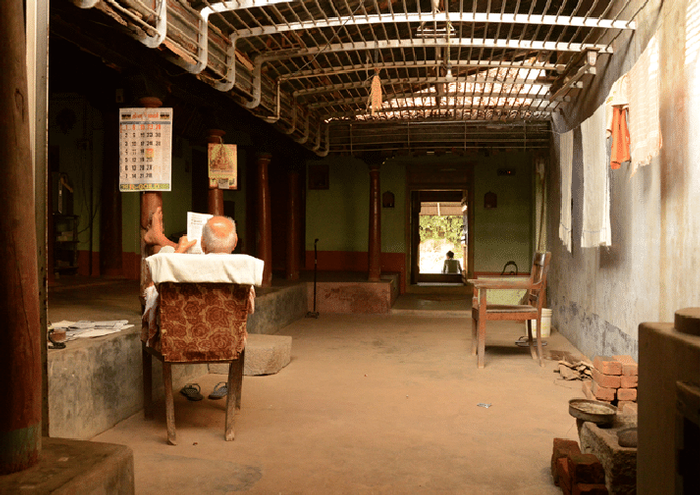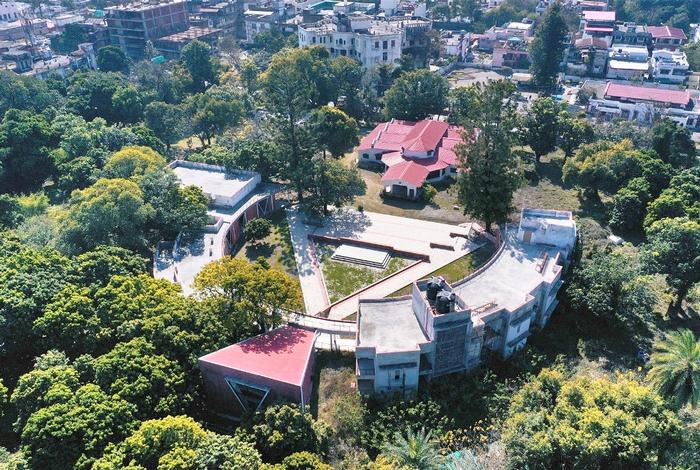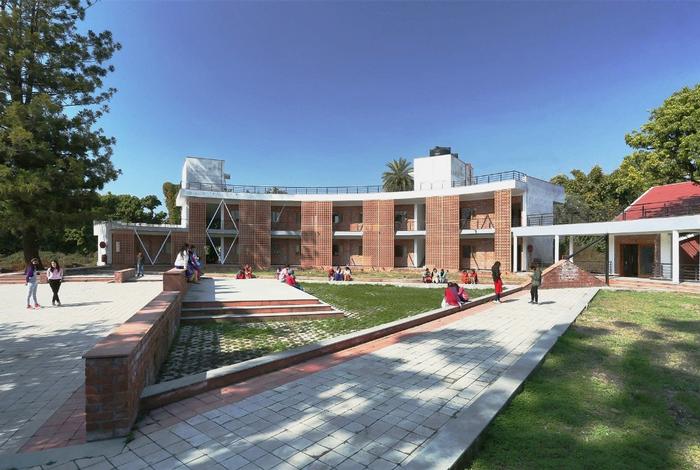[ID:4868] Embracing the Autumn of LifeIndia Embracing the Autumn of Life
“Oh loved one, The place where your parents and preceptor meet is equal to the three worlds
-there is no place as holy as this. Therefore they are to be treated with the highest respect.”
-Valmiki Ramayana, Book 2 (Ayodhya Khanda), Sloka 34
(dated variously from 500 BCE to 100 BCE)
From time immemorial, India has considered the elderly to be the torchbearers of wisdom, values, culture and traditions which gave them the highest position in the social construct. Ageing was ceremonialized as an ode to the knowledge and experience gathered by the seniors over the course of their eventful lives. With the change in time, the capitalist mindset has coerced the country to cater to the young minds of the nation ensuring a proficient workforce for the future. Slowly, the neglect of the senior population has transposed the idea of ageing from a celebration to a crisis! With the current population of 98 million and a steady growth rate of 3.8% per annum, the senior demographic will soon be an important contributor to society in terms of number and value. Hence it is pertinent to respond to their special needs sensitively.
In the current socio-political milieu, Indian senior citizens are facing problems broadly classified under:
However, the Sanskrit phrase- “Vasudhaiva Kutumbakam” which translates to "The World Is One Family" is an idea that has been strongly adhered to by Indians over time despite its geographical and cultural diversity. With modern developments, lifestyle changes and a drastic shift in family values, Indians have managed to ensure a holistic approach to senior care. We establish this prevalence through the account of two brothers who have gracefully and happily embraced ageing in two very distinct parts of India.
The case of Agraharams
Neelakandan and Keshavan grew up in one of the humble single-storeyed row houses along the Valiyasala Mahadeva Temple in Thiruvananthapuram, Kerala. With generations living under the same roof, these vernacular Agraharams are architectural manifestations of the socio-cultural framework of the atavistic Indian society. The brothers blossomed around their joint family who were temple priests, but managed to get educated to become successful government officials in various towns and cities of India. When their parents fell ill, Keshavan made the conscious decision to move back to his ancestral home along with his family and continued to live there contentedly.
We met Keshavan and his wife as they were interacting with their neighbours, friends and family from the “thinnai” which is a built-in seating arrangement along the entrance veranda. These sitting height projections are well-shaded by the long overhangs of the clay tile-clad roof making it a comfortable space throughout the day for them to develop a sense of belonging. As we were welcomed through these entrances, we noticed that all interior spaces were separated by level differences of small riser heights to establish the diverse degrees of privacy and function. The sunken courtyard brought in great quality natural light and ventilation and acted as a flexible space for religious ceremonies, entertaining close relatives, lounging and drying spices. Keshavan explained that the courtyard has also helped him to keep track of time and to develop a daily routine keeping him busy. His wife, Ratnam, is a retired teacher who tutors neighbourhood children in their study room and also cooks religious favours for the temple. She finds the study and kitchen to be very comfortable since the granite counters are of variable heights giving her the flexibility to work as she sits or stands. Adjacent to the study room is the intricately decorated Pooja room- a sacred space with a collection of idols of Hindu deities dressed in fine silk and lit with oil and ghee lamps during the early mornings and late evenings. To honour their traditions the entrances to these spaces are deliberately lowered to force the users to bow down with reverence as they enter for meditation and chanting hymns.
As we made our way through the pillared corridors and gallery walls that directed us to the private spaces and bedrooms, It was evident that these homes had developed an intangible connection with time since every nook and corner linked to special memories for the residents to accelerate their sense of nostalgia. This temporal character was observed even on the weathered surfaces, wall display niches and furniture. Despite being passed down from generations, these pieces of furniture were customisable by simple hooks and grooves to cater to the desired comfort levels of the user. The red oxide flooring and the lime-washed walls were smooth with a tactile quality which made them easy to dust and mop while having a good grip and being skid-proof respectively. We also noticed that Keshavan tried to make his home accessible via wheelchair using wide planks of reclaimed wood after his wife had a small accident from slipping. When we exclaimed in respite about the temperature difference between the exterior and interior spaces, Keshavan explained that these sustainable earthen homes have been strategically oriented to capture cool breezes directed from step wells and ponds through the aligned windows while avoiding harsh sunlight which helps to significantly cut the cooling costs- going easy on his pocket. Finally, he showed us out through his backyard with purging cassia trees showering us with yellow flowers, medicinal shrubs, thorny bushes along the periphery and organically grown vegetables and fruits which helps reduce the monthly grocery bills significantly.
The roads that connect the backyards and thinnais of all residences ushered us into the religious spine that linked major commercial nodes, community step wells, plazas, Ayurvedic medicine practitioner’s (Vaidhyan) office and temple complexes. These straight roads assist the seniors to venture out, interact and feel independent as they are surveilled through the long windows and verandas facing the street which highlighted the fact that the whole neighbourhood was one big family that looked out for each other.
The case of Assisted Living
With Indian cities urbanising rapidly, rural families- such as Neelakandan’s migrate and fragment from these traditional homes to modern apartment complexes or housing societies. Upon meeting with him, we learnt that he chose to keep working to earn for his extended family in various cantonments. With every new posting, he noticed that the new buildings coming up were bound by strict building bye-laws imposed by the National Building Code of India which ensured universal accessibility and barrier-free environments but showed no regard to the importance of social interaction and belonging. In his last posting to Dehradun before retirement, he was transfixed by the natural beauty and favourable climate of the hill station and chose to settle there.
Urban exodus and brain drain have not just affected the economy but have created a void in the family framework resulting in seniors being asked to move to retirement homes. Such was the case of Neelakandan and his wife Thankam as well. Despite being a fairly new concept in the Indian context, the couple championed the idea with excitement and chose the Nest Inn facility for assisted living as their new home. They found traces of their ancestral home and its intangible quality in this facility and took no time to get involved into the community and its activities. Designed by Myspace Architects, the facility aims to bridge the gap between generations to provide a safe haven for its residents. Nestled within the foothills of the Himalayas, The 4-acre plot is an independent ecosystem within a densely populated urban environment that is surrounded by lush green mango and lychee orchards and vegetable gardens. It is abutted by a main road towards the West which connects the facility to Dehradun’s multi-speciality hospital, Gurudwaras, Temples and railway station.
We were welcomed into the facility by the spirited smiles of Thankam and her friends working in a thriving skill development centre open to women from the neighbourhood to help them generate a passive income. Well-lit by clerestory windows, the rudimentary structure was previously the servant quarters for the British bungalow adjacent to it, but retrofitted erroneously to function as studios and class rooms. The Colonial bungalow stands in all its glory and commands the landscape around, and acts as the primary foci for the circular structure of the facility behind it. As we made our way through the meadows, we noticed multiple organically planned seating spaces beneath the trees where seniors played board games, read newspapers and made phone calls. The dense foliage slowly made way into a large open space with a triangular plaza and open-air theatre which were the first spaces we walked through to reach the facility. The curvilinear built form of the living facility is said to represent the circle of life where living spaces, a meditation hall, a dining-kitchen block, and a multipurpose hall are arranged along a circular spine terminated by two existing trees. The architects also stated that the circular construction facilitates the developer to expand the facility by radiating outward.
The idea of the “thinnai” has been carefully translated into singly loaded shaded corridors and balconies which assist the interaction of the residents from a public space into the private. The central walking track and plaza ensures a steady vigilance of the seniors by the in-house nurses. Although the new structure is incapable of clasping onto old memories of the residents, it tries to help them beckon for these stories and accounts from their lifetime in the skewed meditation hall which starts off with low compressed ceilings and slowly opens into a framed panoramic view of the orchards thereby connecting their revitalised bodies with nature. Weekly theatre productions, talent shows and poetry recitals are held with great enthusiasm at the bordering multi-purpose hall to develop the feeling of oneness via participation and collaboration. This hall is also rented away for public events with the condition of involving the seniors in the event. Thankam recounts that the space also hosts birthday celebrations of kids from the nearby orphanage which accounts for her happiest memories in her new home. As we approached lunchtime, Neelakandan took us to the dining hall designed pragmatically for serendipitous conversations over a meal. Echoing with youthful vigour, we watched the seniors tap their spoons and forks against their plates singing to old Bollywood tunes as they waited for their food to be served. We were informed by the cooks that they make it a point to prepare local delicacies from a selected member’s state once a week, for a sense of nostalgia. However, the kitchen is open to the seniors only during special occasions such as religious festivals to prepare their favours of choice. Post lunch as they proceeded to their rooms for an afternoon nap, we got a chance to have a glimpse into one of them. Scented with the aroma of incense sticks, these rooms had a colourful accent wall decked with family photographs, cards from grandchildren, framed certificates, and trinkets. A corner of the room (generally the North/East) was dedicated for their religious practices. These personalised rooms were impressively well equipped with holding bars, anthropometric furniture, night lights, tactile paving, audio-responsive lighting, accessible toilets and an expansive private balcony. Interestingly all the seniors chose to leave their doors open to allow the afternoon sun to filter through the decorative trellis walls and for the warm winds to ventilate their spaces. Later, we sat down with the nurses to understand how the facility caters to the special needs of their residents. They elucidated that the seniors are asked to fill out a detailed form recording their medical history with a list of their prescribed medication, frequency of specific tests and the contact information of the on-call doctor and immediate family. After careful inspection of these reports, special case patients are identified and are monitored on an hourly basis whereas the general residents are allowed to carry on with their day independently under careful supervision and timely reminders to take medications. A comprehensive full body checkup is done every month to update their reports and course of medication. For residents with Alzheimer's disease and dementia, the central triangular plaza helps to establish their room’s location and directionality with respect to the triangular pipe detail along the corridor creating an interconnected and memorable ethos.
With the cold evening breeze brushing against the wind chimes, the residents are woken up to get ready for their evening prayers and exercise sessions. After witnessing their daily regimen come to a celebratory end around a fire pit, we bid farewell to Neelakandan, Thankam and their newfound family.
Introspection
As we revisit and introspect the time we spent with these brothers, and their families in their respective homes, it fills us with great enthusiasm to become future architects deeply rooted to the Indian value systems to consciously design and sculpt spaces that are functional, sustainable, aesthetic and socially aware. With the era of transition setting in, these varied approaches to designing for senior citizens emphasise the need to balance traditional and modern beliefs while looking at ageing as a celebration of the vibrant autumn rather than a dreary winter.
References
If you would like to contact this author, please send a request to info@berkeleyprize.org. |




